Aloes are low-maintenance succulents that have gorgeous leaves loaded with healing properties. But how can you benefit from them if the leaves constantly fall off the plant? Leaves falling off are a sign that your Aloe Vera is ill. Today, we will discuss what causes falling leaves in the Aloe Vera plant.
The primary reason behind aloe vera’s leaves falling off is overwatering. Since Aloes thrive in dry conditions, high moisture levels can make the leaves soft and squishy, ultimately falling off. High humidity, poor soil mix, and lack of drainage can also lead to excess moisture buildup.
I will explain all the possible reasons behind Aloe Vera’s leaves falling off in this article. I will also share the solutions to treat the problem. So, let’s get right into the reasons without further delay.
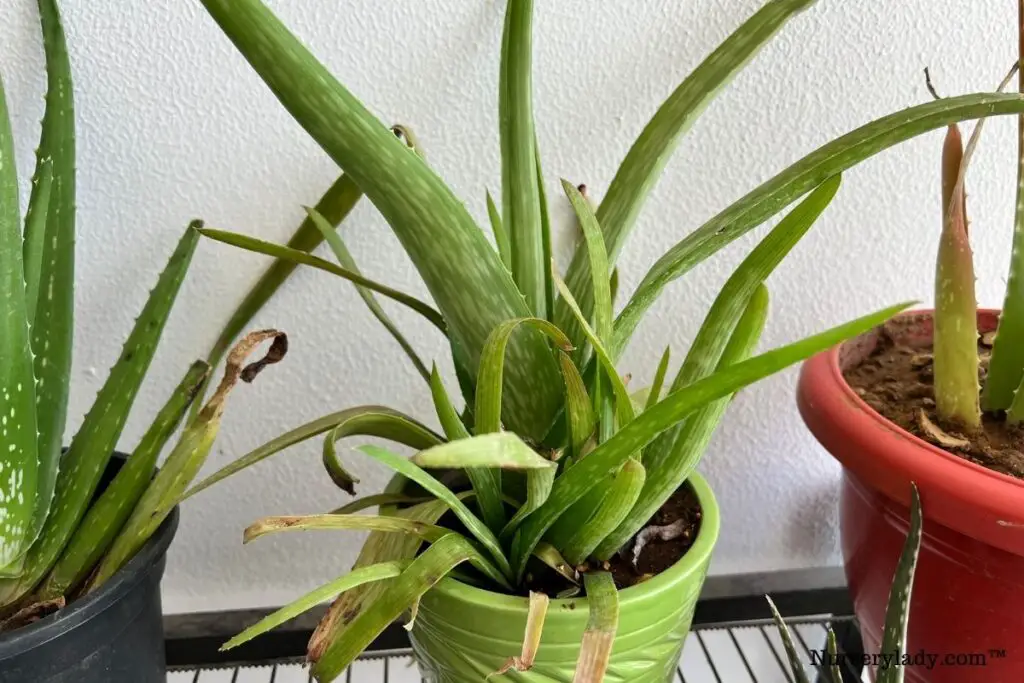
Overwatering
The most common reason behind Aloe Vera losing leaves is overwatering.
Aloes don’t enjoy cold and damp conditions.
They are adapted to grow in dry and warm weather as they belong to the desert areas of the Arabian Peninsula.
When provided with water frequently, the leaves will be highly saturated, thus making them discolored, weak, squishy, soft, and droopy, and ultimately fall off the plant.
How to correct watering?
- For watering the Aloe Vera plant correctly, you should water them only after the top 2-3 inches of the soil has dried out. Only then will the plant be able to take up the water you provide.
- If you must follow a routine, water the Aloes once every 2-3 weeks.
- Scale back watering during the winter months. Due to cold, low sunlight hours, and low evaporation, the soil will take time to dry out.
- During the summers, you should reduce watering when the temperature crosses 80-90°F. The plant will go dormant.
Soil drainage is also connected with overwatering.
Poor drainage will also do the same thing as overwatering.
Even if you water correctly, the soil will remain dry due to poor drainage.
So, have a look at the drainage with correct watering habits.
Use well-drained soil that doesn’t hold water for a long time.
You can use commercial succulent and cactus potting mix.
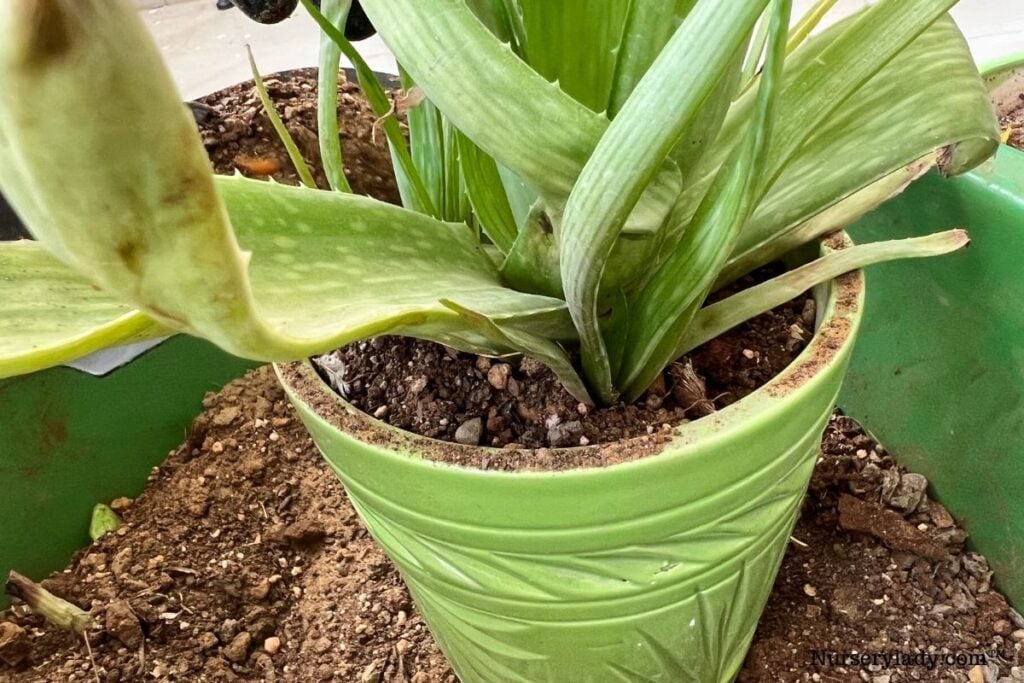
For making the soil mix yourself, try the following suggestions:
Recipe 1
- 50% potting soil
- 50% pumice
Recipe 2
- 3 parts potting soil
- 2 parts pumice
- 1 part peat
Recipe 3
Equal parts of:
Also read:
- How To Water Aloe Vera Plant? (How often, Summer, Winter)
- What Type Of Soil For Aloe Vera Plant? (+Ideal Soil Mix)
Lack of sunlight

Aloe Vera grows best when they receive 4 to 6 hours of sunlight daily.
Depending on the environment they grew from the start, the sunlight can be either full or partial.
But, keeping them in a fully shady place will only lead to the falling of the leaves.
The leaves will become very weak, brittle, and pale.
It also creates problems in producing chlorophyll and proper photosynthesis.
Lack of sunlight also doesn’t allow the soil to dry out quickly.
Due to this, they remain damp for a long time.
Due to all these problems, the leaves will eventually start falling off the plant.
How to give them enough light?
- Shift your plant to a sunny area. But don’t forget to acclimatize.
- If you want to plant aloe outdoors, first select a place that can give enough sunlight. It might give excessive sunlight during summers, but you can fix it by putting on shading nets. It is less complicated than shifting the plants.
- If your Aloe Vera is indoors, keep them near a south or west-facing window. Sometimes, these directions can give too much heat during summer. So, fix sheer curtains. Or, try the north or east-facing window during the summers. It receives less intense but sufficient sunlight.
- The best way to provide the Aloes with sufficient light is to let them have the morning sun for 5 to 6 hours with some shade to protect them from the scorching mid-day and afternoon sun.
Also read: What Kind Of Light For Aloe Vera Plants? (Full sun, Shade, Or Partial Light?)
Looking for gardening supplies? We have tested 100's of products before recommending them to you guys. Check out our best pick below:
| Image | Gardening Supplies | Best Price? |
|---|---|---|
 Top
Top Top
Top | Raised Garden Bed Kit | Check On Amazon |
 | XLUX Soil Moisture Meter, Plant Water Monitor, Soil Hygrometer Sensor for Gardening, Farming, Indoor and Outdoor Plants, No Batteries Required | No Results |
 Top
Top Top
Top | 82 Pcs Garden Tools Set and Extra Succulent Tools Set | Check On Amazon |
 | Joeys Garden Expandable Garden Hose with 8 Function Hose Nozzle, Lightweight Anti-Kink Flexible Garden Hoses, Extra Strength Fabric with Double Latex Core, (50 FT, Black) | No Results |
 Top
Top Top
Top | Dual Chamber Compost Tumbler | Check On Amazon |
 Top
Top Top
Top | Sunnyglade Plant Stakes | Check On Amazon |
 Top
Top Top
Top | Organic Cold Pressed Neem Seed Oil | Check On Amazon |
 Top
Top Top
Top | Mighty Mint Gallon :-Insect and Pest Control Peppermint Oil | Check On Amazon |
 Top
Top Top
Top | Scotts DiseaseEx Lawn Fungicide | Check On Amazon |
 Top
Top Top
Top | Jacks Classic 20-20-20 All Purpose Fertilizer | Check On Amazon |
 Top
Top Top
Top | 30,000 Seeds Pollinator Attracting Wildflower Mixture | Check On Amazon |
 Top
Top Top
Top | Survival Vegetable Seeds Garden Kit-Over 16,000 Seeds | Check On Amazon |
Low temperatures
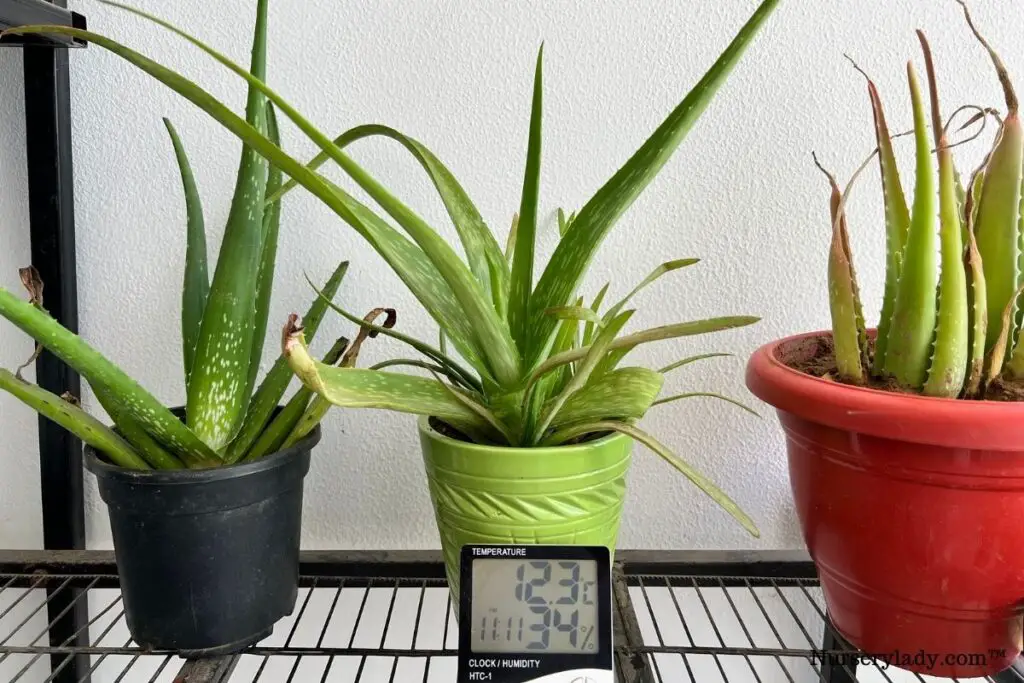
Aloes will also shed leaves if they receive too low temperatures.
As Aloes are habituated to growing around dry and warm weather, they cannot endure cold.
The ideal temperature range for Aloe Veras should remain within 55-75°F.
If the temperature dips lower than 50-55°F, the Aloes will face frost and freeze damage.
Though you can treat frost damage, freeze damage will severely damage the plant.
When the plant is exposed to low temperatures, the water inside the leaves freezes and damages the cells and tissues.
The leaves will feel squishy and soft and lose their color.
Due to the damage to the cells and tissues, the plant will lose its rigidity, droop, and eventually fall off.
How to fix the temperature?
Generally, the indoor Aloe Veras don’t receive low temperatures because the temperature remains within the range inside the house.
- But, you shouldn’t keep them close to air conditioners and fans as that will give them cold.
- If your Aloe Vera is outside, bring them inside when the temperature drops below 55°F in your region.
- If your area receives frost, grow Aloes in containers to bring them inside in winters.
- You can keep the Aloe Veras outside to let them have full sun during the day. It can keep them warm. But keep it outside only for 3-4 hours. Don’t extend the timing.
- If your aloe is planted in the ground, insulation is required. Keep some stones or pebbles on the surface of the soil bed. This can trap the warmth in the soil and avoid the cold temperature from reaching the roots easily. This mulching technique will also stop the soil from fast evaporation. So, you can scale back watering to a great extent. Try to keep the soil dry during winters.
- Cover your plant with frost clothes to prevent the frost from touching the plant. Make sure the cloth doesn’t touch the plant too.
Also read:
- Can Aloe Vera Plants Survive Cold Weather? (+Deal With Cold Damage)
- Aloe Vera Temperature Tolerance: Ideal Temperature+Keeping Them Safe
Frequent repotting
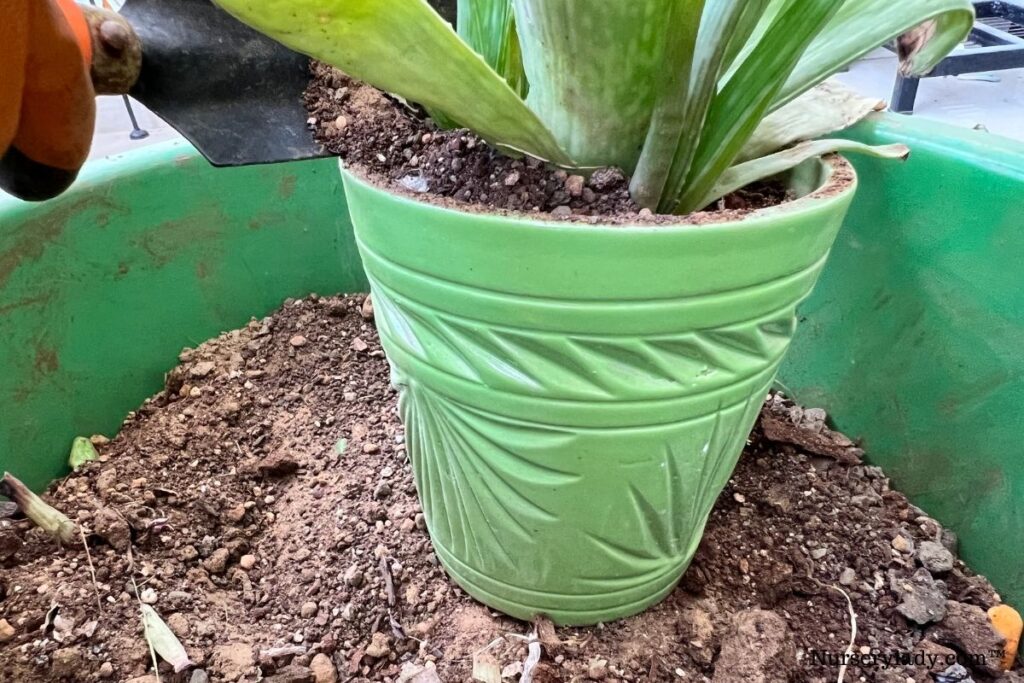
Aloe Veras are fast growers, among other succulents.
But, the indoor Aloes grow very slowly than many other fast-growing succulents due to the difference in light.
The outdoor Aloes receive more light than indoor ones.
You should repot Aloe Veras once every 1-2 years, depending on these conditions.
Indoor Aloes will take more time to mature and repot because they need 3-4 years to reach 8 to 12 inches.
So, you can repot them less often.
However, the frequency will always depend on the plant’s condition.
Aloes are fast-growers among other succulents doesn’t mean you should blindly repot them without checking their state.
If you repot them too frequently, the plant will experience a shock due to frequent changing of their home.
If you constantly change their staying place every time while they are still trying to adapt to the new environment, the plant will lose leaves due to the transplantation shock.
When to repot the Aloes?
- Generally, the Aloe Veras need repotting once every 1-2 years. If they are indoors, take more time to repot them, for example, 2-3 years.
- If you are a beginner, check the signs of root-bound or overcrowding to repot. Whenever you see that the plant is growing roots out of the container holes or out of the soil surface, it is time for repotting.
Also read:
- Does Aloe Vera Plant Like To Be Root Bound? (Possible Problems+Repot)
- How To Repot An Aloe Vera Plant? (Step-by-Step Guide)
Wrong container
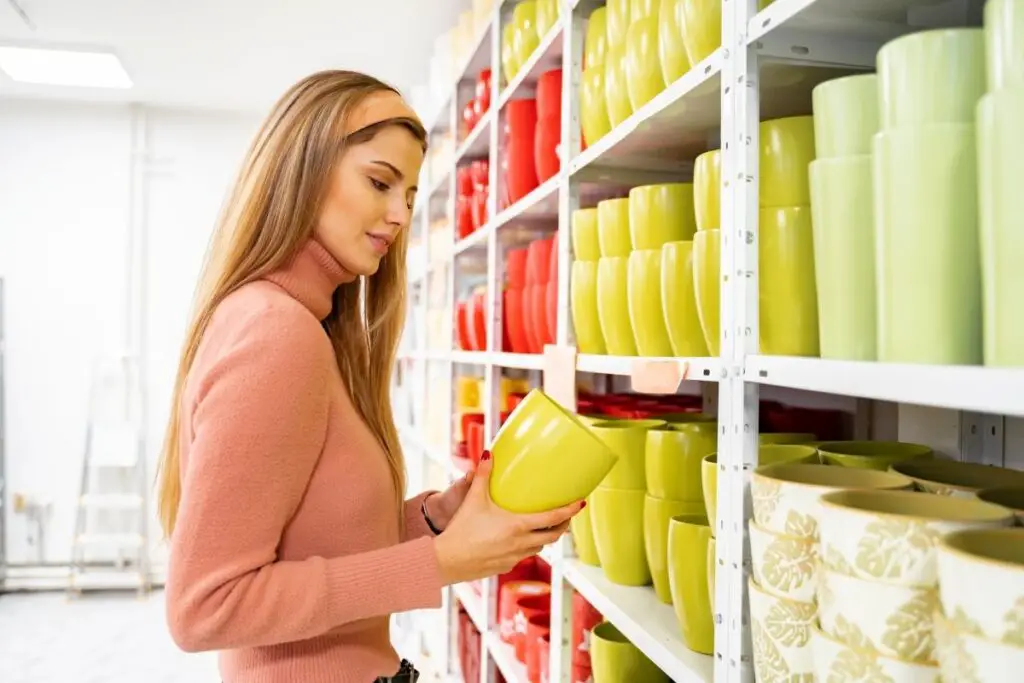
If you want to plant Aloe Vera in containers, you should take an equally deep and wide pot.
If you plant in a very shallow container, the roots won’t be able to grow and spread properly. Without healthy roots, the plant will not remain strong.
If the plant is weak, the leaves too will become weak and fall off the plant.
Don’t use a big container. It will require more soil which takes forever to dry.
As a result, the soil stays moist for a long time, and so do the roots.
This will have the same result as overwatering.
The leaves will become mushy, droopy, and fall off.
What container should I use for Aloe Vera?
- Choose a wider container. The depth should not be more than 2-4 inches because the roots of Aloe Vera spread horizontally more. Also, don’t use a big container.
- The container must have drainage holes. Without drainage holes, the water will remain stagnant, suffocate the roots, rot them and result in falling leaves. So, ensure drainage.
- Using a terracotta container can wick away moisture quickly and keep your plant from prolonged dampness. You can also use other containers like ceramics or plastics, but you have to be careful with watering. If you are a beginner, go for the terracotta.
Also read: What Pot Is Best For Aloe Vera Plant? (Pot Type, Size & More)
Natural cycle
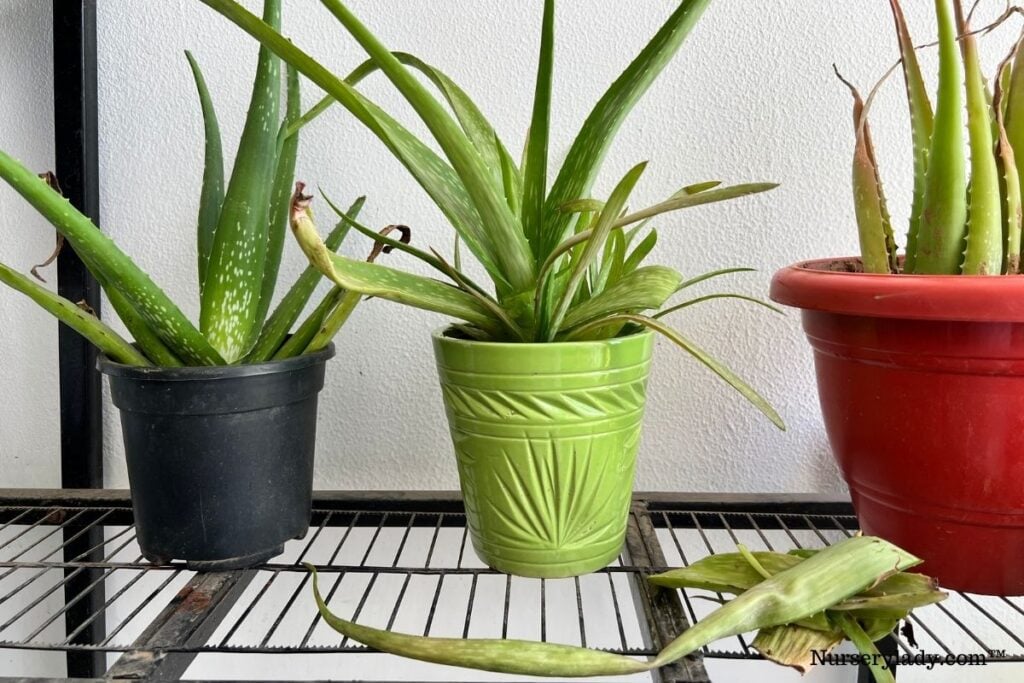
Many gardeners, especially beginners with little knowledge about succulents, are unaware that they lose their leaves naturally.
They will lose the old leaves at the bottom because they have completed serving their purpose.
Now, they will fall off the plant.
They have got covered with leaves at the top, and the old place will get replaced with new leaves.
There is no reason for such conditions, and thus, there is no solution to it.
You must continue with normal care and maintenance and avoid negligence.
However, before they fall off on their own, the leaves might change their color due to aging or losing their energy.
So, if you don’t enjoy the sight, you can remove them yourself. But, if you are new to removing leaves, let them fall naturally.
Chemical shock
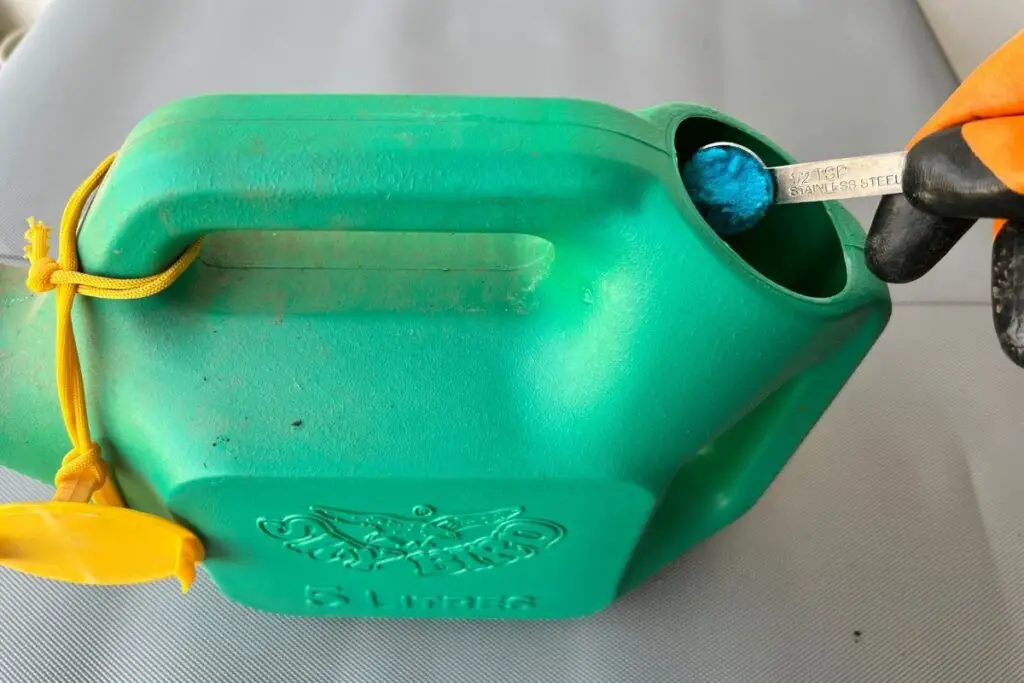
Shocking the system of the Aloe Vera plant by overuse of chemical products will make the plant lose healthy leaves.
When the plant suffers fungus and bacterial diseases or pest infestations, it is tempting to use chemical products because it works instantly.
But, you must read the instructions and caution columns before using them.
Fertilizing excessively too will have the same problems.
Aloes are not heavy-feeders.
Occasional feeding makes the plant grow faster.
Most people want faster growth and use more but end up hurting the plant instead of promoting their growth.
Excessive chemicals affect the plant’s natural growth system, react negatively and cause the plant to lose leaves.
Other symptoms include limp, brittle, and wilted, very small leaves.
How to remedy the situation?
- The white crystals on the soil surface are salt accumulation due to over-fertilization. You need to flush the soil thoroughly to wash the salts from the soil.
- Get rid of the damaged and fallen leaves from the plant to prevent infestation.
- Stop fertilizing for some weeks. Don’t apply any chemicals until the plant recovers fully.
- If you want to use pesticides or fungicides, try the organic and homemade ones to prevent such burns.
- In the future, if you ever use chemical-based products, you should read the instructions carefully before applying. Also, look at the caution part. Use less than recommended. Less is more.
- Always dilute the fertilizer to half the recommended strength and never apply in dry soil.
Also read: Does Aloe Vera Need Fertilizer? (How Much, How Often+Best Pick)
Diseases
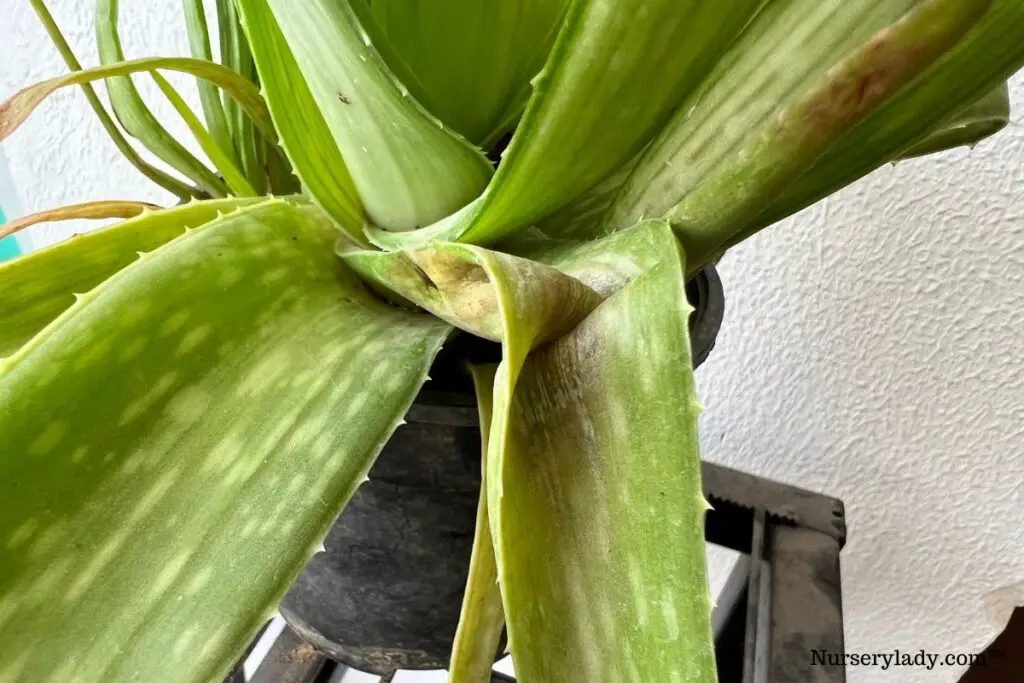
Diseases like Aloe Rust and Bacterial Soft Rot will also lead to falling leaves.
Aloe Rust is caused by the fungus Phakopsora pachyrhizi.
The fungus travels and gets transferred to the aloe plant by the wind.
The leaves having yellow or dark spots, orange spores, and falling leaves are some of the common symptoms.
Bacterial Soft Rot is a bacterial disease caused by the bacteria Pectobacterium chrysanthemi.
The bacteria enter the plant’s defense system and injure the structure of the plant.
Damp, dark spots enlarging over time, lower leaves will wilt and drop off the plant.
How to get rid of diseases?
To get rid of Aloe Rust:
- Stop watering for 1-2 weeks and let the soil dry out.
- If your potted aloe plant is standing over a saucer, empty it immediately.
- Change the position of the plant and take it to a sunny spot for fast drying of the soil.
- Let the plant have some space around for good air circulation.
To get rid of Bacterial Soft Rot:
- If several tissues of the plant are damaged, revival will be next to impossible.
- You must cut off the infected leaves from the plant, provided only a few leaves are infected. You have to discard the whole plant if all the leaves are affected.
- You can propagate them if there are healthy pups or healthy leaves. However, most gardeners try the former as the latter results in shriveled leaves.
Can I use the fallen leaves?
If the leaves are healthy, you can try to propagate them.
But the damaged and discolored leaves won’t be of any use.
Even if you try to propagate the healthy fallen leaves, you may not get good results.
It is because Aloe Vera doesn’t respond much to leaf propagation.
But, you can try ones to see the outcome.
Brief care tips to keep the aloe leaves from falling
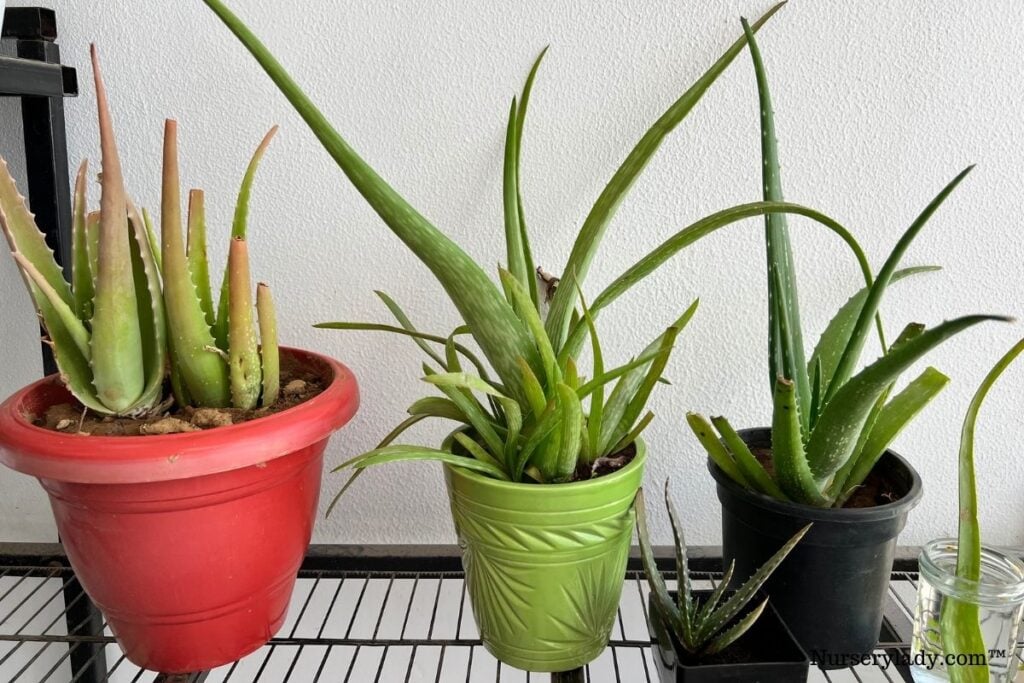
- Let the Aloe Vera plant have enough sunlight but not intense. They should get at least 4-5 hours of sunlight per day.
- Water only when the top 2-3 inches of the soil is dry. During the winters, water them sparingly. The growing medium should stay almost dry.
- If your plant is overwatered, there may be chances of fungal development and more leaf loss. To avoid this, spray some fungicide on the plant, especially in the roots. It will avoid further fungus development.
- Maintain a temperature between 55 and 75°F. Bring the Aloes inside during winters. Never keep the plant close to air conditioners or fans. Also, don’t keep them close to open windows or doors during winters.
- Ensure the drainage. Use well-drained soil. Also, use a container with drainage holes.
- Repot only when the plant needs it. Watch for signs of root-bound or overcrowding.
Final thoughts
If you ever see your Aloe Vera is suddenly falling leaves, try to inspect the problem. Also, compare it with the reasons I shared in this article. Take immediate steps and solve the problem as suggested.
Don’t delay in fixing the issue. If you ignore the problem just because the damage is less or your Aloes are endurable, you will be pushing your plant into a danger zone.
Revival will be hard and impossible if the damage level exceeds 50%.
So, never delay fixing the problem. Follow the care tips to prevent the plant from losing leaves and keep them healthy.
Reference: NCBI, New York Botanical Garden, University of New Hampshire, University of Florida, Wikipedia.
